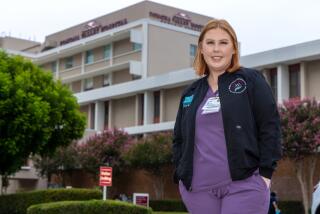The Family Nurse : Medicine: Mary Jones, who diagnoses diseases and issues prescriptions, is one of the stateâs few nurse practitioners. If organized nursing has its way, there will be more.
VENTURA â Mistrustful of condoms, Pete Barnum-Wood, 26, wanted a more foolproof birth control method.
So who did she call?
The family nurse.
âMary never talks down to me,â Barnum-Wood explains. âPhysicians, be they male or female, often do.â
From her offices in a pumpkin-colored concrete building across from Venturaâs Community Memorial Hospital, Mary Jones issues prescriptions, performs cervical biopsies and diagnoses diseases from chlamydia to cancer.
Thereâs no doctor at her Channel Islands Womenâs Health Center, but Jones, 43, pays obstetrician-gynecologist Richard Reisman to review her charts and supply pre-written prescriptions for 30 common medications, hormones and contraceptives. As California law requires, she follows standardized procedures developed with him.
Bid goodby to the image of nurse as subservient handmaiden.
From Santa Monica to Sonora, at least a dozen other California nurse practitioners have struck out on their own over the past decade, competing directly with doctors for patients.
And if organized nursing has its way, future Yellow Pages will have a âNurse Practitionersâ listing as fat as todayâs âPhysicians & Surgeonsâ section. Health insurance policies will cover nurseâs visits to homes, schools, nursing homes and job sites, and employers will offer workers low-cost nursing HMO plans.
Studies by academic nursing researchers and others show nurse practitioners have lower overhead costs than doctors, prescribe fewer drugs and spend more time teaching patients how to prevent disease. Nursesâ patients miss fewer appointments, comply better with treatment plans and are more satisfied with their care when compared to doctorsâ patients, other health research shows. And several nurse practitioners can be trained for the cost of educating one physician.
At a time when primary care physicians are in short supply and one in six Californians lacks health insurance, these are compelling findings.
âAny effort to reform this countryâs health-care system must include an expanded role for nursing,â argues Patricia Moccia, executive vice president of the New York-based National League for Nursing. âYouâre just rearranging deck chairs on the Titanic otherwise.â
*
Nurse practitioners are registered nurses with one to two years extra training in a specialty such as gynecological, pediatric or geriatric nursing.
After four years of undergraduate nursing school leading to her R.N., Jones completed a one-year nurse practitioner program in obstetrics and gynecology at Atlantaâs Emory University School of Medicine. Later she finished a one-year pediatric nurse practitioner program offered by Fulton County, Ga., and a two-year masterâs program in obstetrical nursing at UCLA.
Still, none of that prepared for the hostility some Ventura doctors aimed her way when she went solo in 1985.
Jones invited 50 of the townâs doctors to a catered open house shortly after launching her practice. Three showed up.
âI wouldnât send my dog to one,â one of her first new patients was told when she called a Ventura physician to ask about nurse practitioners, Jones says.
âIs it true you couldnât get into medical school?â she says other new clients wanted to know. âThatâs what my doctor said.â Another false rumor had Jones performing abortions, a clear violation of the law: Nurses may not perform surgery.
Reisman says that the ill will involved more than turf concerns: âA lot of physicians honestly believe if a patient goes to a nurse practitioner, the entire picture may not be seen and the correct diagnosis may not be made.â
Dr. Kin Jung, a Ventura family doctor, is one. âWhen it comes to your abdominal pain, do you want to be diagnosed by someone with two years of training or someone with eight years of training?â he asks.
âThereâs no way around it. You canât distill eight years of training into two.â
But in some circumstances, two years may be enough, some research suggests.
In a 1986 report to Congress, the U.S. Office of Technology Assessment concluded that within nurse practitionersâ areas of training, nurse practitioners provide care quality âequivalentâ to physicians.
And one study published last year in the Archives of Internal Medicine found nurse practitioner care âmore appropriateâ than a physicianâs care.
Researchers posed this hypothetical case to 501 doctors and 298 nurse practitioners: A man complains of intermittent sharp stomach pains that improve after meals and intensify on an empty stomach. An endoscopic exam, performed a month earlier, revealed moderately severe stomach inflammation, but no ulcer.
Nurse practitioners were âfar more likelyâ to ask questions eliciting information about the patientâs excessive drinking, smoking and aspirin use, his habit of skipping breakfast and dinner and his sonâs recent death. Nurses also were more likely to prescribe grief counseling and lifestyle changes--the âmore appropriateâ treatment, according to the studyâs authors.
About two-thirds of the doctors--versus one-fifth of the practitioners--prescribed drugs.
Barnum-Wood, also a nurse, first became a patient of Jones 10 years ago, when Jones still worked for Reisman. Barnum-Woodâs mother and sister are Jonesâs patients, too.
Barnum-Wood made the appointment to discuss birth control methods because she was about to undergo a series of hepatitis vaccines, a precaution recommended for all health-care workers. Because the vaccineâs effects on a developing fetus arenât known, she wanted to make sure she didnât get pregnant with her second child for at least six months.
âWhat do you want to do?â Jones asked.
âIâm not sure,â her patient replied.
Jones suggested that birth control pills are the most reliable contraceptive: âBut itâs up to you. It is a chemical.
âOr you could use a barrier method, but youâve had problems with yeast, and nonoxynol-9 can make that worse. And with your work schedule and a little one at home . . . â
âIâll try the pill,â Barnum-Wood said, which triggered a 15-minute discussion regarding proper use of oral contraceptives, potential side effects and tips for avoiding them.
Her bill for the half-hour office visit was $50--slightly more than a doctor might charge for dispensing birth control pills. But Jones argues that a doctor wouldnât have taken time to provide the same depth of information. She contends well-informed patients require less follow-up care, making longer visits cost-effective in the long run.
If Barnum-Wood had seen a doctor--or a nurse practitioner employed by a doctor--her health insurance would have covered part of the bill. Because she went to a self-employed nurse, however, she had to pay the entire amount.
The American Medical Assn. and California Medical Assn. oppose organized nursing efforts to eliminate this insurance obstacle. AMA policy opposes independent medical practice by any non-physician and argues that direct reimbursement would make it easier for nurses to work independently.
In the summer issue of Yale Journal on Regulation, published by Yale Law School, associate dean and author Barbara J. Safriet characterizes this as âlegal and market domination by physiciansâ and a major obstacle preventing nurse practitioners from realizing their full promise and potential.
Nevertheless, California now requires private insurers to reimburse nurse practitioners for prenatal care, and Medicaid, Medicare and the Federal Employees Health Benefits Plan must reimburse practitioners for some groups of patients, such as pregnant women and those living in medically underserved rural areas.
But thatâs not enough to allow Jones to give up moonlighting. To make ends meet, she teaches nursing at UCLA and works at Ventura Collegeâs student health center.
Jones is not the only struggling nurse entrepreneur. A 1988 American Nurses Foundation survey of 185 solo practitioners found half made under $30,000 a year and needed a second job to survive. Nurse practitioners who work for doctors can make twice that.
Meanwhile, Jones asks patients to pay cash at each visit.
Barnum-Wood says she doesnât mind: âMary gives me information and asks me what I want to do.â
âA doctor just looks and pokes. And then he decides.â






